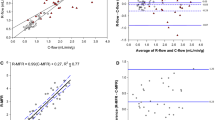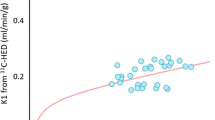Abstract
Objective
11C-acetate has been applied for evaluation of myocardial oxidative metabolism and can simultaneously estimate myocardial blood flow (MBF). We developed a new method using two-parameter spillover correction to estimate regional MBF (rMBF) with 11C-acetate PET in reference to MBF derived from 15O-H2O PET. The usefulness of our new approach was evaluated compared to the conventional method using one-parameter spillover correction.
Methods
Sixty-three subjects were examined with 11C-acetate and 15O-H2O dynamic PET at rest. Inflow rate of 11C-acetate (K1) was compared with MBF derived from 15O-H2O PET. For the derivation, the relationship between K1 and MBF from 15O-H2O was linked by the Renkin-Crone model in 20 subjects as a pilot group. One-parameter and two-parameter corrections were applied to suppress the spillover between left ventricular (LV) wall and LV cavity. Validation was set using the other 43 subjects’ data. Finally, rMBFs were calculated using relational expression derived from the pilot-group data.
Results
The relationship between K1 and MBF derived from 15O-H2O PET was approximated as K1 = [1–0.764 × exp(−1.001/MBF)] MBF from the pilot data using the two-parameter method. In the validation set, the correlation coefficient between rMBF from 11C-acetate and 15O-H2O demonstrated a significantly higher relationship with the two-parameter spillover correction method than the one-parameter spillover correction method (r = 0.730, 0.592, respectively, p < 0.05).
Conclusion
In 11C-acetate PET study, the new two-parameter spillover correction method dedicated more accurate and robust myocardial blood flow than the conventional one-parameter method.




Similar content being viewed by others
References
Brown MA, Myears DW, Bergmann SR. Validity of estimates of myocardial oxidative metabolism with carbon-11 acetate and positron emission tomography despite altered patterns of substrate utilization. J Nucl Med. 1989;30:187–93.
Sun KT, Yeatman LA, Buxton DB, Chen K, Johnson JA, Huang SC, et al. Simultaneous measurement of myocardial oxygen consumption and blood flow using [1-carbon-11]acetate. J Nucl Med. 1998;39:272–80.
Herrero P, Kim J, Sharp TL, Engelbach JA, Lewis JS, Gropler RJ, et al. Assessment of myocardial blood flow using 15O-water and 1-11C-acetate in rats with small-animal PET. J Nucl Med. 2006;47:477–85.
Katoh C, Yoshinaga K, Klein R, Kasai K, Tomiyama Y, Manabe O, et al. Quantification of regional myocardial blood flow estimation with three-dimensional dynamic rubidium-82 PET and modified spillover correction model. J Nucl Cardiol. 2012;19:763–74.
Yoshinaga K, Tomiyama Y, Suzuki E, Tamaki N. Myocardial blood flow quantification using positron-emission tomography. Circ J. 2013;77:1662–71.
Wu YW, Naya M, Tsukamoto T, Komatsu H, Morita K, Yoshinaga K, et al. Heterogeneous reduction of myocardial oxidative metabolism in patients with ischemic and dilated cardiomyopathy using C-11 acetate PET. Circ J. 2008;72:786–92.
Katoh C, Morita K, Shiga T, Kubo N, Nakada K, Tamaki N. Improvement of algorithm for quantification of regional myocardial blood flow using 15O-water with PET. J Nucl Med. 2004;45:1908–16.
van den Hoff J, Burchert W, Borner AR, Fricke H, Kuhnel G, Meyer GJ, et al. [1-(11)C]Acetate as a quantitative perfusion tracer in myocardial PET. J Nucl Med. 2001;42:1174–82.
Buck A, Wolpers HG, Hutchins GD, Savas V, Mangner TJ, Nguyen N, et al. Effect of carbon-11-acetate recirculation on estimates of myocardial oxygen consumption by PET. J Nucl Med. 1991;32:1950–7.
Timmer SA, Lubberink M, Germans T, Gotte MJ, ten Berg JM, ten Cate FJ, et al. Potential of [11C]acetate for measuring myocardial blood flow: Studies in normal subjects and patients with hypertrophic cardiomyopathy. J Nucl Cardiol. 2010;17:264–75.
Manabe O, Yoshinaga K, Katoh C, Naya M, deKemp RA, Tamaki N. Repeatability of rest and hyperemic myocardial blood flow measurements with 82Rb dynamic PET. J Nucl Med. 2009;50:68–71.
Herrero P, Markham J, Shelton ME, Bergmann SR. Implementation and evaluation of a two-compartment model for quantification of myocardial perfusion with rubidium-82 and positron emission tomography. Circ Res. 1992;70:496–507.
Tsukamoto T, Morita K, Naya M, Katoh C, Inubushi M, Kuge Y, et al. Myocardial flow reserve is influenced by both coronary artery stenosis severity and coronary risk factors in patients with suspected coronary artery disease. Eur J Nucl Med. 2006;33:1150–6.
Chan SY, Brunken RC, Phelps ME, Schelbert HR. Use of the metabolic tracer carbon-11-acetate for evaluation of regional myocardial perfusion. J Nucl Med. 1991;32:665–72.
Sun KT, Chen K, Huang SC, Buxton DB, Hansen HW, Kim AS, et al. Compartment model for measuring myocardial oxygen consumption using [1-11C]acetate. J Nucl Med. 1997;38:459–66.
Burger C, Buck A. Requirements and implementation of a flexible kinetic modeling tool. J Nucl Med. 1997;38:1818–23.
Klein LJ, Visser FC, Knaapen P, Peters JH, Teule GJ, Visser CA, et al. Carbon-11 acetate as a tracer of myocardial oxygen consumption. Eur J Nucl Med. 2001;28:651–68.
Naya M, Murthy VL, Blankstein R, Sitek A, Hainer J, Foster C, et al. Quantitative relationship between the extent and morphology of coronary atherosclerotic plaque and downstream myocardial perfusion. J Am Coll Cardiol. 2011;58:1807–16.
Goldstein RA, Kirkeeide RL, Demer LL, Merhige M, Nishikawa A, Smalling RW, et al. Relation between geometric dimensions of coronary artery stenoses and myocardial perfusion reserve in man. J Clin Invest. 1987;79:1473–8.
Yoshinaga K, Katoh C, Noriyasu K, Iwado Y, Furuyama H, Ito Y, et al. Reduction of coronary flow reserve in areas with and without ischemia on stress perfusion imaging in patients with coronary artery disease: a study using oxygen 15-labeled water PET. J Nucl Cardiol. 2003;10:275–83.
White CW, Wright CB, Doty DB, Hiratza LF, Eastham CL, Harrison DG, et al. Does visual interpretation of the coronary arteriogram predict the physiologic importance of a coronary stenosis? N Engl J Med. 1984;310:819–24.
Naya M, Di Carli MF. Myocardial perfusion PET/CT to evaluate known and suspected coronary artery disease. Q J Nucl Med Mol Imaging. 2010;54:145–56.
Siegrist PT, Gaemperli O, Koepfli P, Schepis T, Namdar M, Valenta I, et al. Repeatability of cold pressor test-induced flow increase assessed with H(2)(15)O and PET. J Nucl Med. 2006;47:1420–6.
Acknowledgments
The authors thank Hidehiko Omote, RT; Shigeo Oomagari, MSc; and Eriko Suzuki for their support of this study. The study was supported in part by grants from the Ministry of Education, Science and Culture Japan (Category Young Investigator, No. 40443957 and the Ministry of Education, Science and Culture Japan (No. 10292012), and by a Japan Radiological Society Bayer Grant.
Author information
Authors and Affiliations
Corresponding author
Appendix: 1-parameter and 2-parameter spillover method
Appendix: 1-parameter and 2-parameter spillover method
Relational expression among R(t), C t(t), and Ca(t) was represented as Eq. 3 for the conventional method and as Eq. 4 for the two-parameter method.
where α denoted myocardial tissue ratio in the ROI R, and (1–α) is spillover from blood into the ROI R.
where vα is spillover from blood into the ROI R for the two-parameter method.
Activity concentration in the LV blood cavity was modeled as a partial-volume mixture of arterial blood and myocardial tissue as Eq. 5.
where β denoted a recovery coefficient in the LV ROI, (1–β) is spillover from myocardium into blood pool, and m is the density of myocardial tissue (1.04 g/ml). Radioactivity in the LV blood pool was calculated using Eq. 5 with β = 85 % [4].
The change in tissue activity concentration was modeled using the one-tissue compartment model as Eq. 6.
where K1 (mL/g/min) is the uptake rate from blood into the tissue and k2 (/min) is the washout rate from myocardial tissue into the blood C a(t) (Bq/mL). The parameters K1, k2, α and vα were estimated by the non-linear least-squares method using Eqs. 3, 5, and 6 for the one-parameter method and Eqs. 4, 5, and 6 for the two-parameter method. Estimated data and the curve R(t) dedicated the spillover-corrected pure blood curve C a(t).
Rights and permissions
About this article
Cite this article
Mori, Y., Manabe, O., Naya, M. et al. Improved spillover correction model to quantify myocardial blood flow by 11C-acetate PET: comparison with 15O-H2O PET. Ann Nucl Med 29, 15–20 (2015). https://doi.org/10.1007/s12149-014-0904-z
Received:
Accepted:
Published:
Issue Date:
DOI: https://doi.org/10.1007/s12149-014-0904-z




